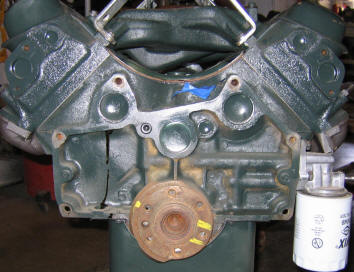
1955-60 Pontiac Engine Component Interchange & Identification
by Larry Gorden
Technical Advisors Rick Gonser & Bill Hanlon
March 2008, updated Nov 2012, Jan 2013.
Contents -- Scroll down to read this article sequentially or use links below to quickly jump to an area of interest:
This article describes the 1955 through 1960 Pontiac engines, the so called “square block” engines (because of a squared off interface to the rear of the engine). It is meant to help you identify engines and engine components, and to understand options for interchanging engine components within those years.
In 1961, Pontiac made several engine changes which eliminated much of the compatibility with earlier 1955-60 engines. For a complete list of Pontiac V8 engines for all years, see "Pontiac V8 Engines".
Because many engine components have have the same bolt-on interface within the 1955-1960 model years, there is considerable interchangeability of parts within those years. The interface is the same to the back of the engine, heads to block, exhaust manifolds to heads, intake manifolds to heads, front cover to block, oil filter to block, distributor, etc.
Rear Block Interface. Within the years 1955-60, the bell housing (flywheel cover) interface to the rear of the engine is the same so any year bell housing will bolt up to any year engine block. The rear flange on the crankshaft is also the same so flywheels interchanges between those years. This means any year transmission & bell housing may be bolted up to any year engine.
However, if you are mating a 1955-56 dual-range hydramatic to a later engine, you may run into a problem with mating the hydramatic flywheel to the later crankshaft flange. Here's what Rich Gabrielson said about installing a '59 engine in his 55 2-door sedan.
"When I put a 59 389 in my 55 Chieftain and bolted it to the 55 hydro flywheel the flywheel wobbled and wiped out the trans front pump. The problem was the 389 had balance weights on the crank flange and the 287 didn't. The weights were in the way and wouldn't let the flywheel mount flush to the crank. I had to have the flywheel turned at the crank flange area on a brake drum lathe until the weights would clear, then had the flywheel rebalanced and all fit then and has been together now for 19 years."
Another option for solving this problem would be to grind down outer edge of the flange -- prior to getting the crankshaft balanced. Check closely if you are mating a dual-range hydramatic to a later (after 1956) engine. This does not apply to mating a '56 Turbo Flight (controlled coupling) or standard transmission to a later engine -- for those, fit to the later crankshaft flange is not a problem.

1960 rear engine interface (same as 1955-59)
Front Block Interface. The engine front cover (timing chain cover and water pump housing) interface to the block is the same for all years and 1955-59 front covers will interchange. But a 1960 front cover is not interchangeable with earlier years -- a 1960 front cover must be used only with a 1960 block. See Engine Cooling for more discussion of the front covers and differences in engines due to water flow change in the 1960 model year.
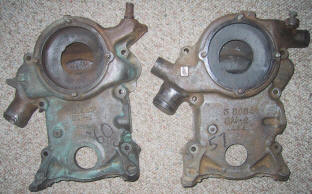
1960 and 1957 engine front covers
Oil Pump. (Per Rick Gonser) 1955-58 are Type 1 while 1959-60 are Type 2. The Type 2 pump remained the same until 1979, thus all of the Mellings pumps interchange. Not so for the Type 1.
Engine Interchange. A 1959 or 60 engine (389 cid) may be used to replace an earlier V8 engine without any motor mount changes -- and makes for a nice quick-and-easy cost-effective performance upgrade. For example, installing a 1959 engine in a 1955 Pontiac increases displacement from 287 cid to 389 cid and improves intake and exhaust performance. I did this back in early 60's with my 1955 Pontiac 2-door sedan stick-shift tri-power hot rod -- and shucked several transmissions but parts were readily available at salvage yards back then. Cost is minimal because the 1959 engine bolts into the earlier chassis.
The relatively simple installation of a 1959-60 engine in an earlier chassis requires that you use the original (or compatible) transmission bell housing for motor mount compatibility. For such an engine replacement, you can use the right exhaust manifold from a 1957 or later engine (including original manifold on the 1959 or 60 engine). For the left exhaust manifold, you need to use a 1957 or 58 manifold; later manifolds will interfere with the steering box. 1955 or 56 exhaust manifolds will bolt up to 1959 or 60 heads but exhaust ports are smaller in the 55 & 56 manifolds so they are not a good choice. If you're doing this engine swap then you'll want to modify the exhaust system with larger exhaust pipes.
Also, if you are making this swap, that is installing a 1959-60 engine in earlier chassis, be aware that the power steering pump in the earlier chassis will not bolt up to the 1959-60 front cover because the front cover does not have the needed mounting bolt holes. 1959-60 power steering pumps were mounted off to the side of the engine and did not use the front cover for mounting. If you're installing a 1959 engine, this is not a big problem because you can use an earlier front cover that has the power steering mounting provision. But it is a problem for the 1960 engine because an earlier front cover must not be mounted on the 1960 engine unless some machine work is done on the block.
Master Parts Catalog. The Pontiac Master Parts Catalog is a good resource for investigating interchangeability of parts. If a part number has a range of several years, you can be quite certain that the part is interchangeable for that range of years. For example, suppose you need to buy or sell a 1955 Pontiac oil pan. Here's what we find in the Master Parts Catalog

which shows us the same part number for 1955-58; thus the oil pan is interchangeable within those years. The Master Parts Catalog tells a lot about parts interchangeability but it doesn't tell the whole story, some parts are interchangeable but don't have the same part number.
There are several ways to identify 1955-60 engine blocks including:
(1) Block Casting Number on passenger’s side of block.
(2) Vehicle identification (VIN) stamped on front passenger's side of block.
(3) Casting date on back of block near distributor hole.
(4) 59 and 60 engines have threaded holes on side of block for motor mounts, earlier V-8s do not.
(5) Internal components such as displacement (bore / stroke) and main journal size.
I discuss the first three below but first some terminology.
Cast codes are embedded in the engine block mold and are created as the block is cast. The liquid metal pored into the mold doesn’t always closely follow the contours of the mold, leaving codes that are sometimes difficult to read. Cast codes are also used on the heads, intake, exhaust manifold, and other cast parts.
Here are the two types of codes on an engine block.
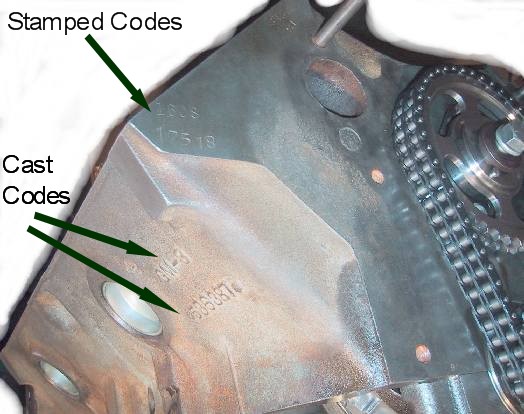
1960 Engine
| Year | Block Casting Number | cid | hp | 4-bolt mains |
| 1955 | 518037 | 287 | 173, 180, 200 | |
| 1956 | 521560 | 316 | 192, 205, 216, 227, 285 | |
| 1957 | 523293 | 347 | 227, 244, 252, 270, 290, 317 | |
| 1958 | 528456 | 370 | 240, 255, 270, 285, 300, 315, 330 | |
| 1959 | 532000 | 389 | 215, 245, 260, 280, 300, 315 | |
| 1959 HO | 532000 | 389 | 330, 345 (420A engine) | YES |
| 1960 | 536387 | 389 | 215, 230, 235, 281, 283, 303, 318 | |
| 1960 HO | 536387 | 389 | 333, 348 (425A engine) | YES |
| 1960 SD* | 536387 | 389 | 348, 363 (425A engine) | YES |
* Denotes Over-The-Counter "Daytona" Package
The block casting number is located on the right side (passenger's side) of the engine block below the cylinder head surface and identifies the model year for the engine block. Note the casting number in the picture above is 536387 so from the table we can identify it as a 1960 block. Here is a 1956 block. Notice that the casting number is centered between the freeze plug holes rather than at the front of the engine like the 1960 engine.
1956 Engine Block
The car serial number, also called "Vehicle Identification Number" or VIN, is usually stamped into the engine for the car it is installed in. This serial number is stamped on the front passenger's side of the block, just below the head surface. Since the year of a car can be read from the serial number then the year of the engine can be read from the serial number stamped on it.
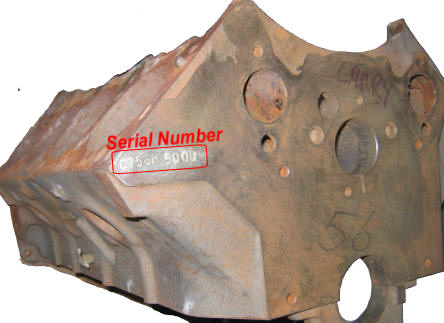
1956 Engine Block - Serial Number
See Identification Tags for description of the "serial tag" and meaning of codes within the serial number. There are two digits in the code that identify the year of the car/engine. For the years 55 through 58, the year is the third and fourth characters in the serial code. For example, P756H5000 on the block above identifies it as a 1956 block. For 1959 and 1960, the year is in the second and third characters of the VIN. A code of 160S17518 identifies a 1960 model (second and third characters are "60").
A "matching numbers" engine in a Pontiac will usually have the same serial number stamped into the engine as the serial number of the body. I'm told that not all Pontiacs were produced with matching serial numbers on the body and the engine block so non-matchng numbers does not necessarily mean the engine is not original.
According to Rick Gonser, Chief POCI Judge, the serial number was not always stamped into the block. Here's what he had to say:
"In the early years, GM Assy Manuals called for stamping the VIN [serial number] on the block, but left it up to the individual Assy Plants. Often times, the blocks were stamped such that the VIN is "under" the timing cover, and not readily visible unless the cover is removed. Other times, they simply didn't stamp it at all, since it did not become a Federal requirement until 1964. "Matching" numbers were instituted by Chevrolet, thus the nice, easily read pad at the front of the block. B-O-P opted out of this requirement, until GM finally forced them into compliance in the late '60s...:
The date code is cast on the back of the engine block near the distributor. It tells the date that the block was cast and some consider this the best method to determine the year of an engine block. Here's an example.
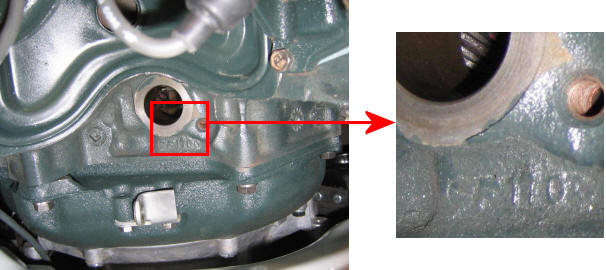
Block date code
It is difficult to read but appears to be "F110".
The date code gives month, day, and year when the block was cast. The month is represented by a single letter, "A" is January, "B" is February, etc. The day is one or two digits following the letter. The year is represented by the last digit. In this example, "F" represents June, the day is 11 and the year is represented by "0". This engine block was cast on June 11, 1960, identifying it as a 1960 model year block.
Remember for early production cars, many blocks were cast in the prior year so the year cast is not necessarily the same as the model year (for example, a 1956 block could have been cast in the last few months of 1955).
In 1959-60, as each engine was completed at the Pontiac assembly plant, a 1 or 2 character code was stamped on the block to identify the application for the engine. The code is stamped on the front of the block, passenger side just below the head and beside the water pump. The complete engine code consists of the engine assembly plant sequence number (commonly called "motor number") with the engine code under it.

1960 engine stamped codes
Engine code on the above engine is S1. A list of codes and meanings can be found in the Master Parts Catalog (p. 60-61) or Shop Manual.
| Year Model | Head casting number | Valve size (in.) intake/exhaust | Comments | Combustion Chamber cc |
| 1955 | 518024 | 1.72 / 1.50 | 73.0 | |
| 1956 | 522010* | 1.72 / 1.50 | 192, 205, 216, 227 hp | 69.6 |
| 522845 | 1.72 / 1.50 | 285 hp (2x4v) | 58.0 | |
| 1957 | 523298 | 1.88 / 1.60 | 227, 244, 252, 270, 290 hp | 66.0 |
| 52(4852)** | 1.88 / 1.60 | 317 hp (F.I.) | 66.0 | |
| 1958 | 528511 | 1.88 / 1.60 | 70.2 | |
| X 528511 O | 1.88 / 1.60 | T395A | 65.0 | |
| XX 528511 XX | 1.88 / 1.60 | F.I. | 65.0 | |
| 1959 | 531395 | 1.88 / 1.60 | 74.7 | |
| X 531395 O | 1.88 / 1.60 | All 3x2 carb & T420A | 68.6 | |
| 1960 | 536109 | 1.88 / 1.60 | 71.3 | |
| X 536109 O | 1.88 / 1.60 | All 3x2 carb & T425A | 66.8 | |
| X 535461 O | 1.92 / 1.66 | SD*** | ??? |
* Standard head milled 0.072" also provides 10:1 compression (285 hp engine) per Factory Bulletin
** Last 4 digits stamped on O.E. install
*** 1960 SD heads were over-the-counter or dealer installed only
Head casting numbers with leading or trailing "X", "XX", "O", or "L" indicate that something out of the ordinary was done to the head after it was cast. These special characters were not a part of the casting number but were stamped into circular pads to the left (leading character) or right (trailing character) of the center head bolt. XX was stamped into both left and right on 1958 fuel injection heads. Left X indicates high compression and L indicates low compression. Right O indicates heavy duty valve springs. This example is a 1958 head with high compression indicated by X stamped on the left circular pad.
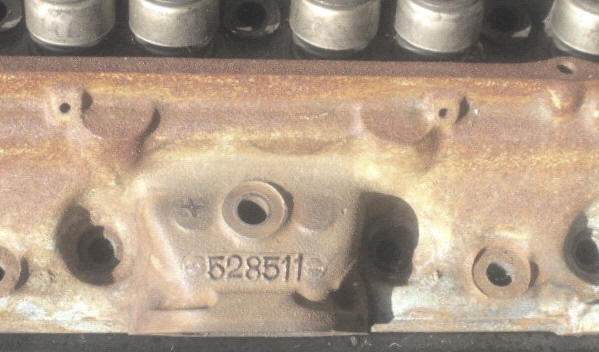
1958 High Compression Head indicated by "X" on left circular pad (photo by Rick Gonser)
1955 heads will "bolt" onto a 1960 block and vice versa. But when swapping heads, be aware that there are other issues to consider such as valve size, port sizes, valve clearance, altered compression ratio, and use of the water distributing tube in the heads.
1960 heads do not use the water distributing tubes used in 1955-59 heads (see Early Pontiac V-8 cooling). So if you are installing earlier heads on a 1960 block, you must remove the tubes. If you are installing 1960 heads on an earlier block, you must install 1957-59 tubes.
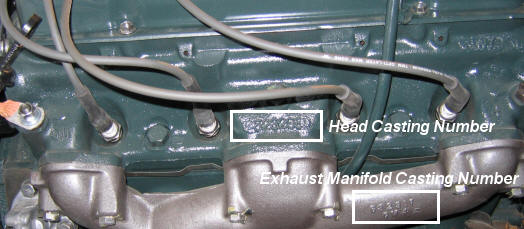
Since the head casting numbers are easily read from under the hood, they may be the quickest way to identify the model year of an engine -- assuming the heads are original for the engine. In the above photo of an what might appear to be a stock engine (to some) in a 1956 Pontiac, the head casting number and exhaust manifold casting number reveal 1957 heads and 1960 exhaust manifold.
Right = passenger's side, Left = driver's side
| Exhaust Casting Numbers | |||
| Year Model | Right | Left | Elbow* |
| 1955 | 533837 | 518089 | NA |
| 1956 | 521624 | 521630 | 521701 |
| 1957 | 523538 | 523539 | 523771 |
| 1957 FI | 524883 | 523539 | 528612 |
| 1958 | 528596 | 528598 | 529549 |
| 1958 FI | 530374 | 528598 | 530573 |
| 1958 T395A | 530961 | 530965 | 530966 |
| 1959-60 | 532312 | 532311 | NA |
| 1959-60 HO | 532215 | 532216 | NA |
| 1960 SD | 535504 | 535505 | NA |
* The elbow was used on the left side for dual exhaust only
Exhaust manifolds interchange between 1955 through 1960 and later. That means any year exhaust manifold will bolt up to any year heads. However you must be aware of other issues such as will the manifold fit in the chassis, are the exhaust port sizes compatible and will the header pipes fit the manifold. Early heads/manifolds used smaller ports than later heads/manifolds.
These photos show 1960 engine installed in 1956 Pontiac. Note that a 1959-60 left exhaust manifold will not fit into the earlier chassis because of interference with the steering box.
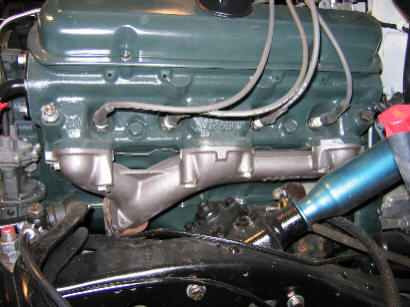 Left side 1958 exhaust manifold |
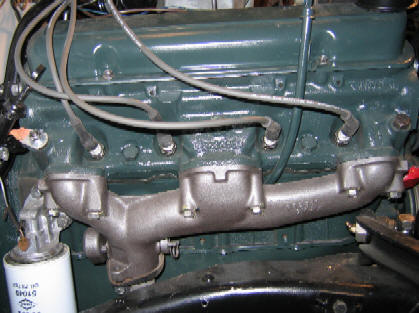 Right side 1960 exhaust manifold |
Exhaust manifold exit ports and exhaust pipes are 1/4 inch larger on 1956 than 1955. As you can see below, ports are larger on 1957 than on 1956.
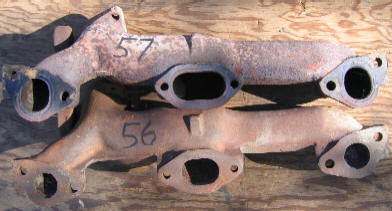
Here's 1956 left exhaust manifold with elbow, used only for dual exhaust installation.
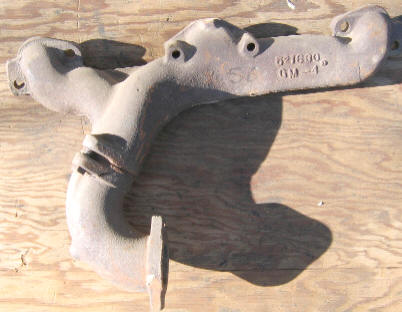
| Year Model |
Intake Casting Numbers | |||
| 2v | 4v | 3 x 2v | 2 x 4v | |
| 1955 | 521510 |
521208* 521512 |
||
| 1956 | 521570 | 521571 | 523554, D32960** | |
| 1957 | 523813 | 523814 | 528533 | |
| 1958 | 528577 | 528578 | 529571 | |
| 1959 | 532119 | 532120 | 532422 | |
| 1959E | 534318 | |||
| 1960 | 536517 | 536518 | 536184 | |
| 1960 SD | 535482 535889*** |
535552 | ||
* Early intake manifold with water temp sensor provision in left rear. Later manifold has water temp sensor mounting in front of manifold.
** Developmental or 1st Design
*** Aluminum
1961 and later intake manifolds are not compatible with the 1955-60 heads although some after market aluminum intake manifolds will interchange.
1955-60 intake manifolds are interchangeable between years, meaning that any year intake manifold will "bolt" onto any year heads. But you must be aware of other issues. Port sizes are not all the same: 1957 and later ports are larger than 1955-56. Carburetor interfaces may be different, for example, 1957-60 4-barrel manifolds have large primary ports (for AFB carb) and 1955-56 do not. Using later carb on 1955-56 four barrel intake manifold will result in vacuum leak. 1959-60 intake manifolds do not have threaded holes for mounting the earlier generator brackets.
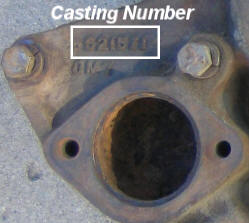 |
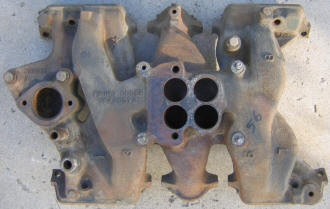 |
| 1956 Intake Manifold | |
Below is an early 1955 intake manifold. Note the hole at the left rear (lower right in photo) which was used for the water temperature sensor. The later 1955 manifolds have the water temperature sensor in the front of the manifold, directly in the return water flow from the driver's side.
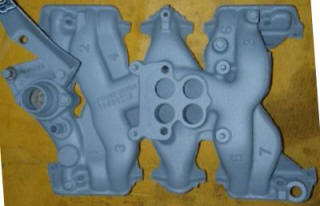
1955 Early Intake Manifold (ebay photo)
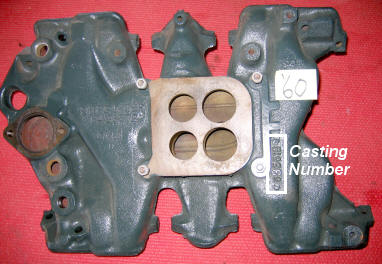
1960 Intake Manifold